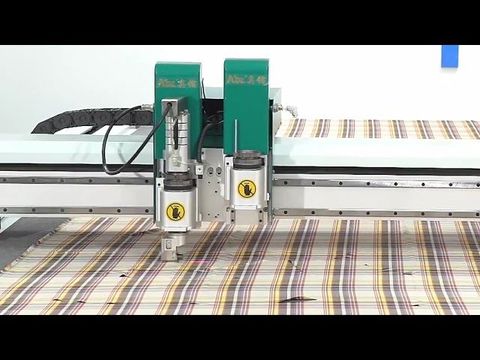A Helpful Overview of Fabric Cutting Machine Types and Features
Fabric cutting machines are tools designed to cut textiles in a precise, consistent, and efficient way. These machines exist because manual cutting often leads to uneven edges, slower production, and higher material waste. As textile manufacturing, garment production, home furnishing, and craft industries have expanded, the need for faster and more accurate cutting solutions has grown.
These machines come in many designs—ranging from small handheld cutters for tailors to advanced automated systems used in large factories. Each type offers different capabilities, from cutting delicate fabrics to handling thick, multi-layer materials. Understanding these machines helps users choose the right equipment based on project size, material type, and required speed.

Importance
Fabric cutting machines play a central role in industries such as apparel manufacturing, upholstery, automotive textiles, and custom tailoring. Their importance is linked to several key factors:
Who It Affects
-
Garment manufacturers
-
Fabricators and upholsterers
-
Small tailoring businesses
-
Textile exporters
-
Designers and crafting professionals
Why It Matters
-
Accuracy: Machines offer consistent and repeatable cuts, improving garment fit and product quality.
-
Speed: Automated systems help increase production output and reduce turnaround time.
-
Material Efficiency: Precise cutting helps minimize fabric waste, which is especially important as material costs rise.
-
Scalability: Businesses can handle larger orders without compromising quality.
-
Safety: Machines reduce the risk of injuries associated with manual cutting tools.
Problems It Solves
-
Irregular cuts from manual methods
-
Time-consuming preparation during bulk orders
-
Difficulty cutting multi-layer fabric stacks
-
Inconsistencies in patterns
-
Labor-intensive operations
Recent Updates
The fabric cutting industry has seen several improvements driven by automation, digital design, and smart manufacturing technologies. Below are some notable trends and updates observed recently:
Key Developments
-
Growth of digital cutting tables: CNC-based cutting systems are increasingly adopted due to their accuracy and ability to interpret digital patterns.
-
Rising use of automatic spreading and cutting systems: Many factories now use integrated systems to reduce manual handling and improve workflow efficiency.
-
Improved safety features: Features like retractable blades, safety shields, and emergency stop systems are becoming standard.
-
Advancements in laser cutting: Laser machines now handle delicate fabrics with minimal edge fraying, especially useful in sportswear and lingerie.
-
AI-assisted pattern optimization: New software solutions are helping manufacturers reduce fabric waste by automating layout planning.
Trend Snapshot Table
| Trend Area | Description |
|---|---|
| Digital Automation | More factories adopting CAD-to-cut workflows |
| Material Compatibility | New blades and laser methods supporting stretch & technical fabrics |
| Sustainability Focus | Machines designed to reduce fabric waste |
| Precision Cutting | Growth of servo-controlled and CNC-guided systems |
These updates reflect the growing need for efficiency, cost control, and sustainability in textile production.
Laws or Policies
Fabric cutting machines are influenced by regulations related to industrial safety, energy efficiency, and workplace standards. While rules vary by country, several common policy areas apply:
Industrial Safety Regulations
-
Requirements for machine guarding to protect operators
-
Standards for blade safety, electrical safety, and emergency stop mechanisms
-
Regulations on workplace ergonomics to prevent repetitive strain injuries
Environmental and Energy Policies
-
Some regions encourage energy-efficient equipment usage in factories
-
Waste reduction guidelines may influence fabric utilization practices
Import and Manufacturing Standards
-
Machines imported for industrial use must comply with national safety certifications
-
Textile manufacturing units must follow local labor and workplace safety rules
Business Compliance
-
Factories must ensure periodic machine inspections
-
Operators often require safety training as part of workplace policies
These policies help promote safer workplaces and responsible manufacturing practices.
Tools and Resources
Various tools and resources support people who work with or plan to purchase fabric cutting equipment. These tools range from software solutions to online guides and industry directories.
Helpful Tools & Platforms
-
CAD Pattern-Making Software – Assists in creating digital designs and exporting them to automated cutters
-
Fabric Utilization Calculators – Helps estimate material consumption for production planning
-
Online Machine Comparison Sites – Useful for comparing cutting speed, blade types, and safety features
-
Maintenance Checklists – Available on industry websites to help keep machines running smoothly
-
Training Videos & Tutorials – Support learning about setup, safety, and fabric compatibility
Common Types of Fabric Cutting Machines Table
| Machine Type | Best For | Key Features |
|---|---|---|
| Rotary Cutters | Tailoring, crafts | Lightweight, circular blade, easy handling |
| Straight-Knife Cutters | Garment factories | High power, suitable for stacked fabric |
| Round-Knife Cutters | Medium-scale units | Curved cuts, compact size |
| Laser Cutters | Technical fabrics | Precision, sealed edges, digital patterns |
| Band Knife Machines | Large production units | Curve cutting, high accuracy |
| Automatic CNC Cutters | Mass manufacturing | High speed, low waste, CAD integration |
These tools and machine types help professionals select the right cutting approach based on material and workflow needs.
FAQs
1. What is the most common fabric cutting machine used in garment factories?
Straight-knife cutters and automatic cutting machines are widely used because they can handle multiple layers and deliver consistent cuts.
2. Can laser cutting machines be used on all fabric types?
Laser cutters work well on many fabrics, including polyester and synthetic blends, but natural fibers may require adjustments to prevent edge burning.
3. Do small tailoring shops need advanced cutting machines?
Most small shops use rotary cutters or compact straight-knife machines. Advanced systems are generally used in large manufacturing environments.
4. What safety measures should be followed when using fabric cutting machines?
Operators should use protective gear, ensure proper machine guarding, follow training guidelines, and keep hands clear of moving blades.
5. How often should these machines be maintained?
Maintenance frequency depends on usage, but regular blade sharpening, lubrication, and safety inspections are recommended.
Final Thoughts
Fabric cutting machines are essential tools that support modern textile production, from small tailoring units to large manufacturing plants. Understanding the different machine types and their features helps users choose solutions that match their fabric needs, production volume, and workspace. With ongoing advancements in automation and digital cutting technologies, these machines continue to improve efficiency, safety, and material utilization across the textile industry.






